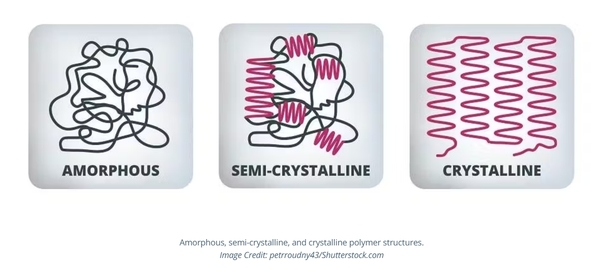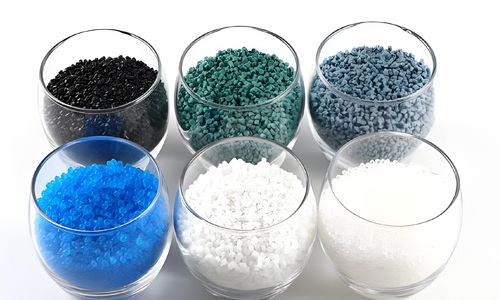Thermoplastic rubber is a material that has the elastomeric properties of rubber while being easy to process using existing thermoplastic processing equipment like injection molding. It must be noted that TPR has different chemistry when compared to rubber and contains no latex. TPR was created to replace typical vulcanized rubber products which are more time-consuming, costly, and difficult to process. The key properties of thermoplastic rubber include excellent fatigue resistance, chemical resistance, impact resistance, and high recyclability. This article will describe the typical properties of thermoplastic rubbers, how they are manufactured, their chemical resistance, and their origin. What Is Thermoplastic Rubber (TPR)? Thermoplastic rubber (TPR) is a semi-crystalline material with both rubber-like and thermoplastic properties. This means it is flexible and can be manufactured using melt processing techniques like injection molding. TPR material is synthesized using block copolymers like SBS (Styrene-Butadiene-Styrene). Thermoplastic rubber can also be described as a thermoplastic elastomer. However, when comparing TPR vs. typical TPE, TPEs are mostly manufactured from SEBS (Styrene-Ethylene-Butadiene-Styrene) based polymers whereas TPRs are manufactured from SBS polymers. What Is the Origin of Thermoplastic Rubber? Thermoplastic rubber became commercialized in the 1950s and was used in the 1960s to manufacture rubber shoe soles that had the properties of rubber but the processing ease of thermoplastics. The origin of TPE can be traced back to pioneering work done by a scientist at B.F. Goodrich Company in the 1920s with the invention of plasticized polyvinyl chloride. What Is the Purpose of TPR Material? TPR material was formulated to be a more easily processed alternative to normal vulcanized rubber. Vulcanized rubber is time-consuming, expensive, and labor-intensive to manufacture. TPR rubber, however, can be just as easily and inexpensively manufactured as other common thermoplastic materials using processes like injection molding. What Are the Properties of Thermoplastic Rubber? The properties of thermoplastic rubber are comparable to those of vulcanized rubber as well as thermoplastics. The following tables summarize the chemical and physical properties of TPR: Chemical Properties Definition Chemical Resistance TPRs show excellent resistance to a wide range of chemicals including: dilute acids, dilute alkalis, oils, grease, and hydrocarbons. Easily Colored TPR can be manufactured in a wide array of colors and can also be painted. Recyclable Due to its thermoplastic nature, TPR can be recycled as easily as other thermoplastics. Table 1. TPR Chemical Properties Physical Properties Definition Impact-resistant Most elastomer materials, including TPR, have excellent compression strength and can therefore withstand impact loads. Temperature Range TPR can maintain its properties across a wide range of temperatures from -40 °C up to 120 °C. Highly Elastic TPR has excellent elasticity that can be compared to vulcanized rubbers and thermosetting elastomers like polyurethane. Wide Range of Hardness TPRs can be made very hard with a hardness range starting at 20 Shore 00 through to a very high hardness value of 85 on the Shore D scale. Flexural Fatigue Resistance TPRs can undergo multiple load/unload cycles without failing due to fatigue. This is why they are often used for shoe soles. Tear & Abrasion Resistance TPR will resist tearing if nicked while also exhibiting excellent abrasion resistance. Electrical Insulator TPR can behave like an electric insulator. Table 2. TPR Physical Properties How Is Thermoplastic Rubber Manufactured? TPR is a block copolymer made up of SBS (Styrene-Butadiene-Styrene), which is essentially a synthetic rubber. SBS, and by extension TPR, are manufactured using living anionic polymerization. This is a chain polymerization process that takes two monomers, namely: butadiene and styrene; and polymerizes them into SBS. This creates a polymer structure that contains hard crystalline regions that consist of styrene and soft amorphous regions that contain butadiene. Styrene provides thermoplastic properties whereas butadiene supplies elastomeric properties. The figure below indicates the differences between amorphous, semi-crystalline, and crystalline molecular structures: TPR is typically produced as plastic pellets that are then used for melt-processing manufacturing techniques, such as the following: Rubber Injection Molding: Molten plastic is injected into a mold to create complex-featured parts. Alternatively, the TPR is molded over a more rigid structure to create soft grips; this process is called overmolding. Blow Molding: Air forces the molten plastic onto the inner surface of a mold to create thin-walled components Extrusion: Molten plastic is forced through a die that enables the manufacture of components with a continuous cross-section Calendering: This process is used to create flat flexible sheets, sometimes with fabric cores. Typical applications are conveyor belts. When Was Thermoplastic Rubber First Introduced to the Market? The actual origins of TPR are not clear, but groundbreaking work in the 1920s and 1930s at DuPont and B.F. Goodrich helped lead to the development of these materials. They first surfaced as a commercially viable product, however, during the late 1950s for the manufacture of rubber soles for shoes. Since then, TPR has expanded out into a wide array of different formulations to support a range of applications. Does Thermoplastic Rubber Contain Latex? No. Thermoplastic rubber is a synthetic rubber and does not contain any actual rubber-related compounds like latex. TPR is manufactured from styrene and butadiene molecules. Thermoplastic rubber is therefore ideal for applications that need the performance and properties of rubber while also containing no latex. Latex is an allergen that may affect some people. Is Thermoplastic Rubber Chemical Resistant? Yes, Thermoplastic rubber material is chemically resistant to a wide array of chemicals. The table below summarizes the chemical resistance properties of thermoplastic rubber to various corrosive chemicals: Corrosive Chemical TPR Material Chemical Resistance Aliphatic Hydrocarbons Excellent Aromatic Hydrocarbons Good Halogenated Hydrocarbons Moderate Dilute Acids Excellent Dilute Alkalis Excellent Alcohols Good Oil & Grease Excellent Table 3. TPR Chemical Resistance Properties Is Thermoplastic Rubber the Best Material for Injection Molding? Yes, TPR is an excellent choice for injection molding due to the melt-processing properties of thermoplastic rubber. It is the best material choice if rubber-like properties are desired while also having good mechanical properties and chemical resistance. For more information, see the Full Guide to Plastic Injection Molding. Is Thermoplastic Rubber Waterproof? Yes, Thermoplastic rubber, like most thermoplastics, is waterproof. TPR plastic is often used to manufacture shoe soles, which need to be waterproof for obvious reasons. To learn more about materials, see our guide on 15 Injection Molding Materials. https://www.xometry.com/resources/materials/thermoplastic-rubber-tpr/
